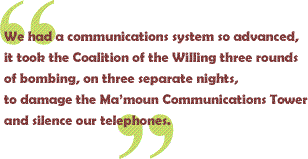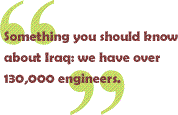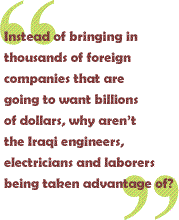 The
Myth: Iraqis, prior to occupation, lived in littlebeige tents
set up on the sides of little dirt roads all over Baghdad.
The men and boys would ride to school on their camels, donkeys
and goats. These schools were larger versions of the home
units and for every 100 students, there was one turban-wearing
teacher who taught the boys rudimentary math (to count the
flock) and reading. Girls and women sat at home, in black
burkas, making bread and taking care of 10-12 children.
The
Myth: Iraqis, prior to occupation, lived in littlebeige tents
set up on the sides of little dirt roads all over Baghdad.
The men and boys would ride to school on their camels, donkeys
and goats. These schools were larger versions of the home
units and for every 100 students, there was one turban-wearing
teacher who taught the boys rudimentary math (to count the
flock) and reading. Girls and women sat at home, in black
burkas, making bread and taking care of 10-12 children.
The Truth: Iraqis lived in houses with running water and electricity.
Thousands of them own computers. Millions own VCRs and VCDs.
Iraq has sophisticated bridges, recreational centers, clubs,
restaurants, shops, universities, schools, etc. Iraqis love
fast cars (especially German cars) and the Tigris is full
of little motorboats that are used for everything from fishing
to water-skiing.
I guess what I’m trying to say is that most people choose
to ignore the little prefix ‘re’ in the words ‘rebuild’ and
‘reconstruct’. For your information, ‘re’ is of Latin origin
and generally means ‘again’ or ‘anew’.

In other words, there was something there in the first place.
We have hundreds of bridges. We have one of the most sophisticated
network of highways in the region: you can get from Busrah,
in the south, to Mosul, in the north, without once having
to travel upon those little, dusty, dirt roads they show you
on Fox News. We had a communications system so advanced, it
took the Coalition of the Willing three rounds of bombing,
on three separate nights, to damage the Ma’moun Communications
Tower and silence our telephones.
Yesterday, I read how it was going to take up to $90 billion
to rebuild Iraq. Bremer was shooting out numbers about how
much it was going to cost to replace buildings and bridges
and electricity, etc.
Listen to this little anecdote. One of my cousins works in
a prominent engineering company in Baghdad – we’ll call the
company H. This company is well known for designing and building
bridges all over Iraq. My cousin, a structural engineer, is
a bridge freak. He spends hours talking about pillars and
trusses and steel structures to anyone who’ll listen.
As
May was drawing to a close, his manager told him that someone
from the CPA [Coalition Provisional Authority] wanted the
company to estimate the building costs of replacing the New
Diyala Bridge on the South East end of Baghdad. He got his
team together, they went out and assessed the damage, decided
it wasn’t too extensive, but it would be costly. They did
the necessary tests and analyses (mumblings about soil composition
and water depth, expansion joints and girders) and came up
with a number they tentatively put forward: $300,000. This
included new plans and designs, raw materials (quite cheap
in Iraq), labor, contractors, travel expenses, etc.
 Let’s
pretend my cousin is a dolt. Let’s pretend he hasn’t been
working with bridges for over 17 years. Let’s pretend he didn’t
work on replacing at least 20 of the 133 bridges damaged during
the first Gulf War. Let’s pretend he’s wrong and the cost
of rebuilding this bridge is four times the number they estimated
– let’s pretend it will actually cost $1,200,000. Let’s just
use our imagination.
Let’s
pretend my cousin is a dolt. Let’s pretend he hasn’t been
working with bridges for over 17 years. Let’s pretend he didn’t
work on replacing at least 20 of the 133 bridges damaged during
the first Gulf War. Let’s pretend he’s wrong and the cost
of rebuilding this bridge is four times the number they estimated
– let’s pretend it will actually cost $1,200,000. Let’s just
use our imagination.
A week later, the New Diyala Bridge contract was given to
an American company. This particular company estimated the
cost of rebuilding the bridge would be around – brace yourselves
– $50 million!
Something you should know about Iraq: we have over 130,000
engineers. More than half of these engineers are structural
engineers and architects. Thousands of them were trained outside
of Iraq in Germany, Japan, America, Britain and other countries.
Thousands of others worked with some of the foreign companies
that built various bridges, buildings and highways in Iraq.
The majority of them are more than proficient - some of them
are brilliant.
Iraqi engineers had to rebuild Iraq after the first Gulf War
in 1991 when the ‘Coalition of the Willing’ was composed of
over 30 countries actively participating in bombing Baghdad
beyond recognition. They had to cope with rebuilding bridges
and buildings that were originally built by foreign companies,
they had to get around a lack of raw materials that we used
to import from abroad, they had to work around a vicious blockade
designed to damage whatever infrastructure was left after
the war – they truly had to rebuild Iraq. And everything had
to be made sturdy, because, well, we were always under the
threat of war.
Over a hundred of the 133 bridges were rebuilt, hundreds of
buildings and factories were replaced, communications towers
were rebuilt, new bridges were added, electrical power grids
were replaced… things were functioning. Everything wasn’t
perfect – but we were working on it.
And Iraqis aren’t easy to please. Buildings cannot just be
made functionary. They have to have artistic touches - a carved
pillar, an intricately designed dome, something unique… not
necessarily classy or subtle, but different. You can see it
all over Baghdad – fashionable homes with plate glass windows,
next to classic old ‘Baghdadi’ buildings, gaudy restaurants
standing next to classy little cafes, mosques with domes so
colorful and detailed they look like glamorous Faberge eggs
– all done by Iraqis.
 My favorite reconstruction project was the Mu’alaq Bridge
over the Tigris. It is a suspended bridge that was designed
and built by a British company. In 1991 it was bombed and
everyone just about gave up on ever being able to cross it
again. By 1994, it was up again, exactly as it was – without
British companies, with Iraqi expertise. One of the art schools
decided that although it wasn’t the most sophisticated bridge
in the world, it was going to be the most glamorous. On the
day it was opened to the public, it was covered with hundreds
of painted flowers in the most outrageous colors – all over
the pillars, the bridge itself, the walkways along the sides
of the bridge. People came from all over Baghdad just to stand
upon it and look down into the Tigris.
My favorite reconstruction project was the Mu’alaq Bridge
over the Tigris. It is a suspended bridge that was designed
and built by a British company. In 1991 it was bombed and
everyone just about gave up on ever being able to cross it
again. By 1994, it was up again, exactly as it was – without
British companies, with Iraqi expertise. One of the art schools
decided that although it wasn’t the most sophisticated bridge
in the world, it was going to be the most glamorous. On the
day it was opened to the public, it was covered with hundreds
of painted flowers in the most outrageous colors – all over
the pillars, the bridge itself, the walkways along the sides
of the bridge. People came from all over Baghdad just to stand
upon it and look down into the Tigris.
So instead of bringing in thousands of foreign companies that
are going to want billions of dollars, why aren’t the Iraqi
engineers, electricians and laborers being taken advantage
of? Thousands of people who have no work would love to be
able to rebuild Iraq… no one is being given a chance.
The reconstruction of Iraq is held above our heads like a
promise and a threat. People roll their eyes at reconstruction
because they know (Iraqis are wily) that these dubious reconstruction
projects are going to plunge the country into a national debt
only comparable to that of America. A few already rich contractors
are going to get richer, Iraqi workers are going to be given
a pittance and the unemployed Iraqi public can stand on the
sidelines and look at the glamorous buildings being built
by foreign companies.
I always say this war is about oil. It is. But it is also
about huge corporations that are going to make billions off
of reconstructing what was damaged during this war. Can you
say Halliburton? (Which, by the way, got the very first contracts
to replace the damaged oil infrastructure and put out ‘oil
fires’ way back in April.)
Well, of course it’s going to take uncountable billions to
rebuild Iraq, Mr. Bremer, if the contracts are all given to
foreign companies! Or perhaps the numbers are this frightening
because Ahmad Al-Chalabi is the one doing the books – he is
the math expert, after all.
Former
exile and Pentagon favorite Ahmad Al-Chalabi was charged in
absentia for embezzling millions from a bank he operated in
Jordan. This entry of Girlblog was found at: http://riverbendblog.blogspot.com/


